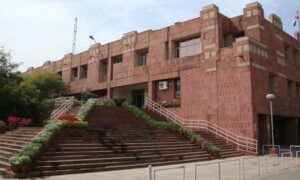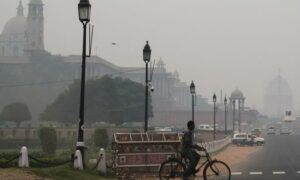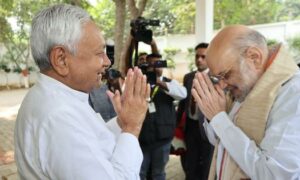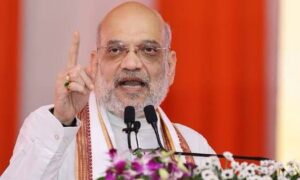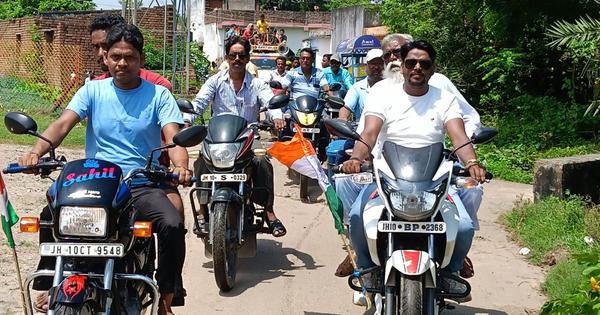
On September 7, a few hundred fishers, mostly Adivasis, participated in a bike rally to protest a proposed floating solar power project on the Panchet dam. It is a 66-year-old multipurpose project located across the river Damodar, along the border of the eastern states of West Bengal and Jharkhand.
The rally started from Maheshnadi checkpost in Neturia block of Purulia district, West Bengal, and travelled a five-km stretch to Panchet Zero Point in Jharkhand’s Dhanbad district.
The fishers staged a demonstration, shouting slogans like “DVC Murdabaad” (down with DVC), “DVC hosiayar” (beware), and “solar project bandh karo” (scrap the solar project).
DVC refers to the Damodar Valley Corporation, a public sector utility that owns and operates the Panchet dam, where floating solar power projects of 105 MW capacity have already been awarded for development. A similar or higher capacity is awaiting the tender process.
Fishers who have been relying on the dam’s waters for their livelihoods allege that nearly 1,500 families would not only lose their livelihoods but also their primary source of affordable nutrition, solely due to the first phase of the project. They have called for a public gathering at Panchet on October 15, calling for the scrapping of the project.
“About 1,500 families of three panchayats in Nituria block – Sarabari, Raibandh, and Guniara – earn their living by fishing from the reservoir. The solar power project will make fishing impossible,” said Rajen Tudu, convenor of the southern West Bengal chapter of Prakriti Bachao O Adibasi Bachao Mancha – platform to save nature and Adivasi people.
Tudu, who is also a leader of the Bharat Jakat Majhi Pargana Mahal, an influential tribal organisation, told Mongabay India that the project would also harm boatmen and fishing net weavers, ultimately affecting nearly 2,500 families.
Apart from Tudu’s organisation, the Damodar Valley Bastuhara Sangram Samiti (committee to struggle for the displaced), Bastuhara Matsyajibi Saagram Samiti (committee to struggle for the displaced fishers), and Jami Raksha Committee (land protection committee) are jointly spearheading the protests.
The Damodar Valley Corporation commands an area of about 24,235 square kilometres in Jharkhand and West Bengal, with its assets including the multipurpose dams at Tilaiya, Konar, Maithon, and Panchet.
Protesters say that the Damodar Valley Corporation officials assured them of alternative livelihood options through cage fishing. However, they are not convinced and allege that the proposals lack clarity.
Mongabay India reached out to the Chief Public Relations Officer of the Damodar Valley Corporation via email, enquiring about the company’s engagement, if any, with the protesters, and their opinion on the allegations made by the fisherfolk and did not receive a response.
Sukhram Hansda, one of the protesters from Neturia, alleged that many tribal families faced displacement without adequate compensation during the early 1950s when land adjacent to the Damodar river had been taken for the dam.
“For nearly a decade and a half, we have been demanding proper compensation from the DVC. Instead of heeding our demand, they now plan to displace us from our livelihood by taking the waters away from us,” Hansda told Mongabay India.
In 2009, the year marking the 50th anniversary of the Panchet dam’s commissioning, residents of several villages adjacent to the dam in Purulia district began a demonstration demanding “adequate compensation.” They alleged that the compensation turned out to be meagre compared to the loss, not every sufferer came within its ambit, and several promises remained unfulfilled.
Since then, villagers have repeatedly raised the charge of unfair and incomplete compensation.
The new project
In its 2022-’23 annual report, the Damodar Valley Corporation stated that it had received approval from the Union Ministry of New and Renewable Energy to establish floating solar parks with a capacity of 989MW at its dam reservoirs under the Ultra Mega Renewable Energy Power Parks Scheme.
Accordingly, a Joint Venture company named Green Valley Renewable Energy Limited was formed, with an equity participation of 49% by DVC and 51% by National Thermal Power Corporation Renewable Energy Ltd, a public sector undertaking.
The Damodar Valley Corporation reported in the 2023-24 annual report that Green Valley Renewable Energy Limited is implementing two Solar PV parks with a cumulative capacity of 755 MW in and around Tilaya and Panchet Dam Reservoirs under the Ultra Mega Renewable Energy Power Parks scheme. Of these 755MW, Green Valley Renewable Energy Limited has awarded contracts for 310 MW Solar PV Projects under Phase I.
This includes awarding the contract to M/s Sterling & Wilson for the 155 MW Floating solar photovoltaic projects at Tilaiya, to M/s. L&T for a 75 MW FSPV at Panchet and to M/s NGSL for an additional 80 MW at Panchet, comprising 30 MW of FSPV and 50 MW of ground-mounted projects.
Tenders for another 455 MW of capacity for Phase II, including at Tilaiya and Panchet, will be floated later. “These projects will not only contribute to our growing renewable energy portfolio but also enhance our efforts to reduce our carbon footprint,” according to the Damodar Valley Corporation annual report.
According to the government, the 100 MW floating solar park commissioned in 2022 in southern India’s Telangana spreads over 500 acres of reservoir water. A 278 MW floating plant in Madhya Pradesh covers over 800 acres.
The Damodar Valley Corporation’s plan is to install a 755 MW capacity at Tilaiya and Panchet. Some of the protesters estimate, based on their interactions with Damodar Valley Corporation officials, that 375 MW are to come to Panchet. Fishers living around the Panchet dam fear losing access to approximately 1,500 acres of water.
“Why don’t they (DVC officials) reduce their power consumption? They travel in AC cars, sit in AC offices, and live in AC homes. How can they take away our livelihood in the name of reducing carbon footprint?” asks Robin Baskey, a Neturia resident.
Protests
Tension began to brew over the solar project at the end of 2024, when the Damodar Valley Corporation authorities held a meeting with local residents regarding the project. Locals say they objected to it immediately. Yet, authorities attempted to proceed with the construction in January.
On January 8, when the project contractor arrived in the Maheshnadi area with workers to commence construction, a gathering of a few hundred locals from different villages within the Sarabari gram panchayat area forced them out. The Bharat Jakat Majhi Pargana Mahal, a social umbrella organisation of tribals, took part in the protests.
The protesters allege that residents of Raibandh and Guniara cross the reservoir on boats to reach the Neturia block headquarters; however, the solar project would eliminate the ferry route. The boat journey takes 10 to 15 minutes. But, by road, it required a 25 km journey, Tudu said.
Since then, protests have been happening at regular intervals. A rally was taken out in February at Purulia’s Neturia. A memorandum was submitted to the Damodar Valley Corporation authorities in March.
“They fooled our forefathers once. They have fooled tribal people everywhere into believing that they have brought in big projects. They never benefit the displaced. Let us not get fooled once again,” Tudu told the protest gathering outside a Damodar Valley Corporation office at Panchet on September 7. They also demanded the construction of a bridge from Bathanbari to Maheshnadi.
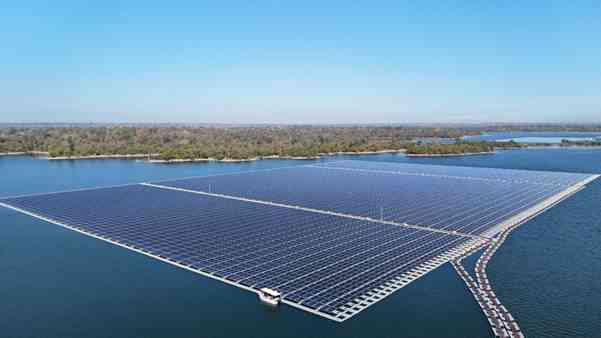
Wider pattern
This is not the first floating solar project to face protests from fishers who depend on fishing in the reservoirs. Fishers in western India’s Maharashtra have been protesting a 1,200 MW floating solar project in Nathsagar reservoir of the Jayakwadi dam.
The project is expected to cover 6,000 hectares of the reservoir. More than 50 fish varieties are found in the Nathsagar reservoir, and locals say that about 25,000 fisher families are dependent on the reservoir.
In western India’s Gujarat, fishers are protesting a proposed 1,500 MW floating solar project on Ukai reservoir, the largest reservoir in the state – commissioned over the River Tapi – which is known for its rich fish diversity.
In central India’s Madhya Pradesh, the 278 MW Omkareshwar Floating Solar Park, which is expected to grow to a 600 MW unit, “showcases the scale and ambition of India’s clean energy goals,” Union Minister Pralhad Joshi had said earlier this year. However, fishers who depended on the Omkareshwar dam’s reservoir for livelihood have reported loss of income.
In 2024, Karnataka state’s initiative in southern India to prepare a pre-feasibility report for the implementation of floating solar installations across 40 lakes managed by the Minor Irrigation Department triggered controversy, as environmentalists expressed concerns about ecological damage to the lakes.
According to Bharath Jairaj, who leads WRI India’s energy program, India faces a complex situation in which the country has ambitious renewable energy targets that could put pressure on land. Therefore, waterbodies are seen as an alternative to land-based solar projects. However, many fishing communities also depend on the same water resources for their livelihoods, which is why similar resource-related conflicts are emerging from floating solar projects as well.
“What is necessary is to conduct studies before launching projects and communicate their results with the fishers. A proper assessment of impact on livelihood, aquatic life, and productivity is necessary to address their concerns,” Jairaj told Mongabay India.
He pointed out that conflicts over scarce resources are inherent to the energy transition, and the process can be made smoother only by taking a consultative approach. “We have to carry the entire society along to make the energy transition successful and meaningful,” he said.
This article was first published on Mongabay.
📰 Crime Today News is proudly sponsored by DRYFRUIT & CO – A Brand by eFabby Global LLC
Design & Developed by Yes Mom Hosting


